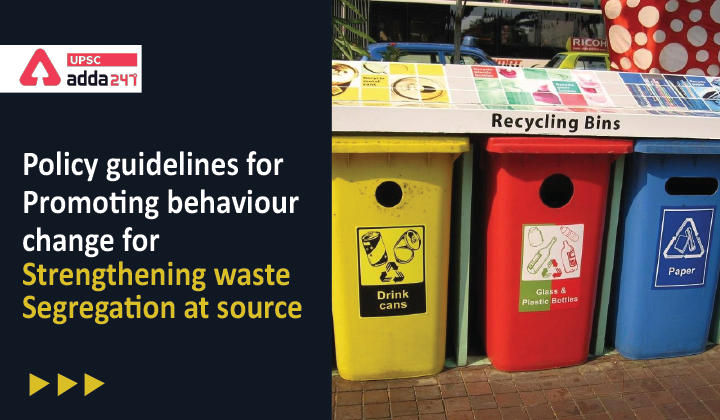Table of Contents
Waste Segregation at Source: Relevance
- GS 3: Conservation, environmental pollution and degradation, environmental impact assessment.
Waste Segregation at Source: Context
- NITI Aayog has recently released policy guidelines for promoting behaviour change for strengthening waste segregation at source.
Waste Segregation at Source (WSS) meaning
- The Solid Waste Management Rules, 2016, states it is the responsibility of generators to segregate waste into three categories — wet, dry and hazardous waste — and hand over the segregated waste to authorised waste collectors or local bodies. It is often called Waste Segregation at Source (WSS).
Waste Segregation at Source: Why needed?
- India generates about 8 million tonnes of solid waste annually.
- World over annual waste generation estimates are pegged at almost 2 billion tonnes, and are expected to grow to 3.4 billion tonnes, an increase of 70% by 2050.
- Countries like India that fall in the world’s fastest growing regions of South-Asia and Sub-Saharan Africa, are projected to witness a much higher, three-fold rise in waste generation by 2050.
- Studies suggest that despite waste management increasingly occupying a position of priority, globally about 33% of the waste is still not being managed in an environmentally sound manner.
- India is facing the issue of legacy wastee., waste that has been left unattended and untreated in dumps for years.
- Most Indian cities are struggling with inadequate finances and infrastructure to effectively collect, treat and dispose-off waste.
- Biodegradable waste in landfills releases methane, which has a 34 times higher global warming potential over 100 years as compared to carbon dioxide
- It is estimated that while 70-95% waste is collected in the major metropolitan cities, collection can be as low as 50% in small cities.
Waste Segregation at Source: Advantages
- Source segregation reduces the need for secondary segregation, which is capital, energy and land intensive.
- Waste segregated at source is least likely to be contaminated with other waste types, and therefore more likely to be recycled. As it is also more likely to be clean, the cost of pre-treatment before recycling or re-purposed is also reduced. For the above reasons, waste segregated at source is more attractive to recyclers.
- The treatment or recycling options for different waste types depends on the nature of waste. More often than not, the processes are cumbersome and expensive. Waste segregation contributes towards reducing the quantum of waste to be treated or recycled, thereby reducing cost.
- It also supports decentralized treatment options like community composting units and dry waste collection centres that are more efficient in waste management.
- Source segregation and recycling results in waste minimization, or lesser waste reaching landfills. This directly translates into longer life spans of landfills, and reduced demand for land for new landfills.
- Waste minimization resulting from primary and secondary segregation also translates into reduced greenhouse-gas emissions from waste dumps and landfills.
- Source segregation reduces the attractiveness of the existing in-human, unhealthy and hazardous practice of rag pickers rummaging through waste piles to salvage saleable waste items.
Also Read:
Draft Extended Producer Responsibility Framework
NITI AAYOG Handbook on Sustainable Plastic Management
Marine Litter and Plastic Pollution Report by UNEP
Beating the Heat: A Sustainable Cooling Handbook for Cities





 TSPSC Group 1 Question Paper 2024, Downl...
TSPSC Group 1 Question Paper 2024, Downl...
 TSPSC Group 1 Answer key 2024 Out, Downl...
TSPSC Group 1 Answer key 2024 Out, Downl...
 UPSC Prelims 2024 Question Paper, Downlo...
UPSC Prelims 2024 Question Paper, Downlo...
